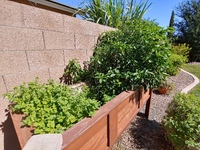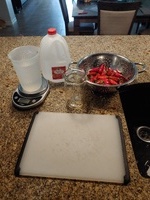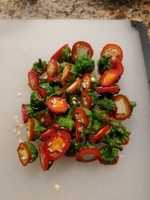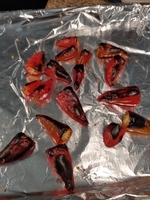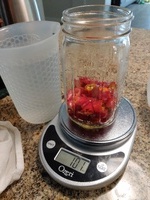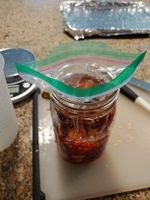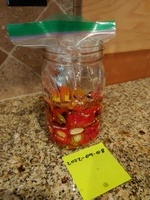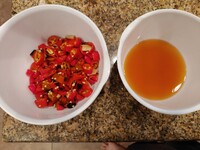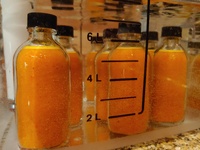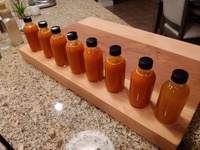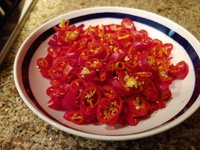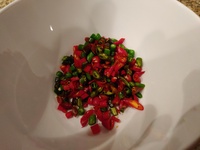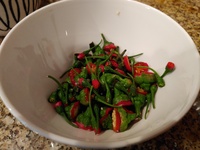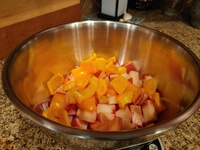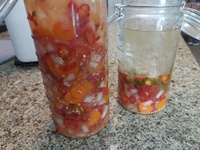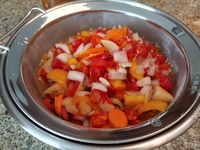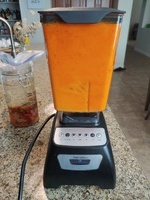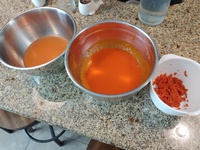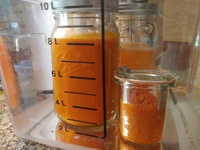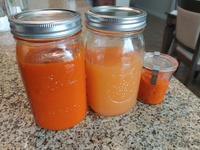I got a pretty nice flush of chilies with the garden this year. As they all ripen in a few waves, I need to figure out something to do with two waves of perfect chilies. They taste great on their own but as I’m the only one in the house with a sufficiently deadened tongue, I need to preserve them.
Pat recommended a fermented hot sauce and that sounds right up my alley. I wanted to take inspiration from that one on GitHub but also do my own thing. I like the method of removing the solids from the finished sauce that they present on SeriousEats. So time to hybridize.
I’ll ferment 50/50 roasted/fresh chilies with garlic in large chunks and finish the sauce with some blending and straining. I want to use fresh-picked chilies so I have a chance of getting some fresh LAB in there. The roasted ones will certainly not have any friendly microbes on the surface.
Mash
| Ingredient | Quantity |
|---|---|
| Fresh Fresno Chilies | 100g |
| Roasted Fresno Chilies | 75g (122g fresh weight) |
| Garlic, Clove, Smashed | 20g |
| Distilled Water | 950ml |
| Kosher Salt | 50g |
- Wash chilies from the garden with non-chlorinated water to preserve lactobacteria that are present. Trim the calyx from all the chilies and roast half under a high broiler until the skins blacken. Let the roasted ones cool before chopping all and adding to a mason jar with smashed garlic.
- Prepare 5% brine solution by thoroughly dissolving salt in distilled water.
- Add brine to chili jar until chilies are just covered (I used 250ml of prepared brine).
- Place a thin ziptop bag in the jar and press to cover the top of the chilies. Fill the bag with remaining brine until an airtight seal forms over the top of the chilies. This technique lets gas escape and prevents contact with oxygen that could encourage mold growth.
- Let ferment 7 days or more until desired pH.
Sauce
I started fermentation on 2022-09-08. I pulled it on 2022-09-13 because it seemed like the fermentation activity had slowed down a lot. Also because it smells incredible and ready to eat. I’m very surprised at the ‘focus’ of the smell. It doesn’t smell harmonious like kimchi, it really just smells of chili and garlic in the best way.
Separate the chilies from their brine and do not discard the brine. I made the sauce to taste, adding to the blender a little at a time. Here are the final measurements:
| Ingredient | Quantity |
|---|---|
| Fermented Fresno Chilies | 238g |
| Distilled Water | 500ml |
| Distilled Vinegar | 125ml |
| Fermentation Brine | 50ml |
I blitzed that until almost completely homogenous, like 5 minutes in the Blendtec. First I tried passing this through my finest metal sieve and that left me with a chili water and a grit paste. I don’t currently have xanthan gum, which would probably add a lot of body to that chili water to make a pleasing sauce. Instead, I opted for adding the silt back because I needed something to improve the thickness. Over time this separates (which would also be mitigated by xanthan gum), but a shake ties it all back together.
After I got the consistency I wanted, I bottled it up. I took care to leave some headroom in the bottles and wiped the neck where the seal would form. Then I heated a 140ºF sous vide bath and left them in for two hours. There are lots of recommendations about reducing pH for shelf stability, but I opted for pasteurization because I’ve had very good luck with the technique for pickling and shelf stability.
My wife likes a couple drops, and I could easily use a third of a bottle on a meal. The brine is also a star, salty and spicy.
Inspired by:
Next Batch
| Ingredient | Quantity |
|---|---|
| Fresno Chilies | 222g |
| Cayenne Chilies | 25g |
| White Peach | 318g |
| Red Onion | 200g |
| Carrot | 145g |
| Orange Bell Pepper | 115g |
| Garlic | 30g |
| Distilled Water | See Notes |
I followed the Noma method but went for a 3% salt content. I added all of the veggies to the crock and added water until they were all submergible. That weighed 1833g which necessitates 55g of salt.
I poured all that out in a bowl and mixed the salt in thoroughly. Putting all that back in the crock, I weighed it down with the water bag trick. I gave it 10 days, then strained, and blended to taste with vinegar and brine.
My scientific rigor fell off with the finishing, but because I’m pasteurizing I don’t need to pay attention to shelf stable pH.
